
Greetings, mirthful Marvel mavens! You’ve arrived in time for the first instalment of Make Mine Marvel, where I’ll wade through the highs and lows of the House of Ideas’ myriad comics from the beginning of the 1970s until… well, who knows! Let’s not waste any time, though, because this week we’ve got bloody war, conservative crimelord politicians, and male chauvinist pigs to get through, so let’s dig in!
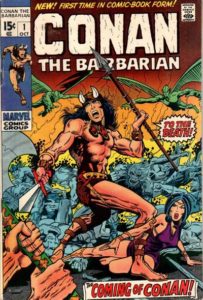 CONAN THE BARBARIAN #1-3 (Oct. 1970 – Feb. 1971):
CONAN THE BARBARIAN #1-3 (Oct. 1970 – Feb. 1971):
Here it is—Marvel’s first step into the Bronze Age!
There wasn’t anything especially groundbreaking about this title straight out of the gate—it was just workhorse writer Roy Thomas teaming up with Barry Smith (later Barry Windsor-Smith), a competent artist who had been coming into his own over the previous several months but hadn’t yet shaken his Kirby-esque affectations. Issue #1’s ‘The Coming of Conan!’ (yes, with exclamation mark) is a serviceable sword and sorcery story, but the most noteworthy part of it is when Sharkosh the Shaman (an evil wizard whose name feels really problematic) looks into his magic gem and sees Conan’s future (“…this barbarian, amidst a hailing populace, crowns himself king of a mighty Hyborian empire!”) and mankind’s future (which includes spaceships that look like Hitachi Magic Wands, the sight of which drive Sharkosh mad).

Conan smashes the jewel, his love interest turns out to be a demoness from another dimension, and Conan walks off down the road to his next adventure.
Issue #2 again sees Conan captured (this time by a race of subterranean ape-men). He again wins his freedom, again sees a friend die, and again walks off empty-handed. Pretty formulaic stuff. It’s not until the next issue that the series really begins to shine.
Issue #3’s “The Twilight of the Grim Grey God!” is adapted directly from Robert E. Howard’s work and it shows. It’s a much more sophisticated story than the previous ones, with Iron Age warlords from two rival nations plotting against each other, Game of Thrones-style. On top of that, Windsor-Smith’s art is really starting to take off, and now owes as much to classic illustrators like Aubrey Beardsley as to Kirby.

Over the course of the tale’s very dense twenty pages, Conan is given many glimpses into the ironies of war…
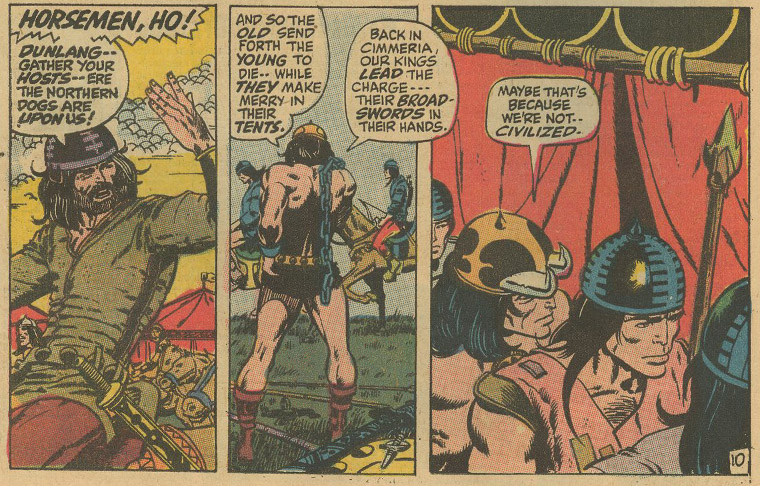
… and is witness to much battle and many tragedies…

…but at the end of the day, there are no victors… not even the Grim Grey God.
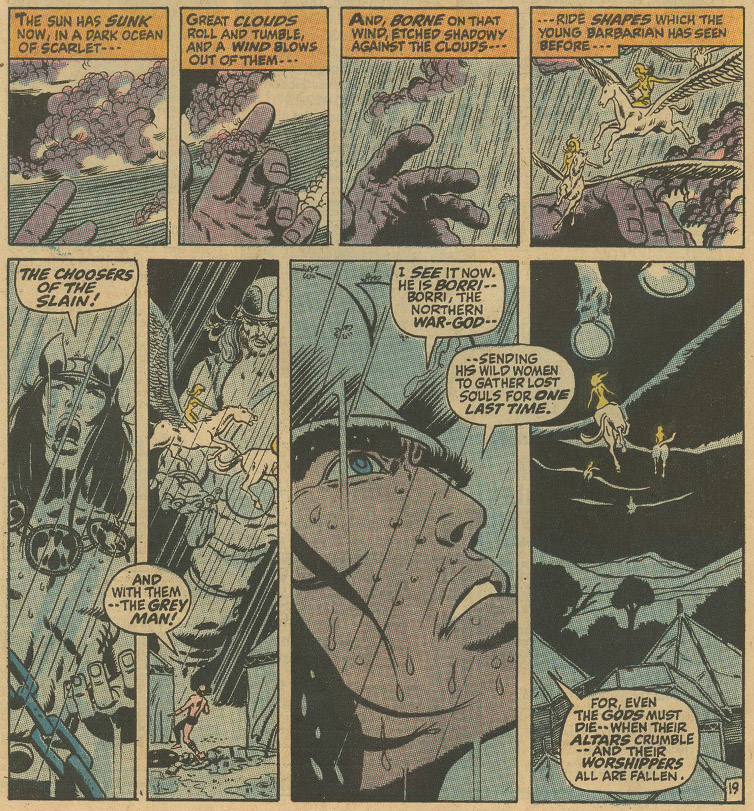
AMAZING SPIDER-MAN #89-92 (Oct. 1970 – Jan. 1971):
While fighting Spider-Man, Doctor Octopus loses control of his tentacles and knocks over a rooftop chimney which threatens to fall on a child. Captain Stacy (a.k.a. upstanding policeman and Spidey’s girlfriend’s dad) pushes the child out of the way, but winds up under the debris himself, fatally injured. In the wake of Stacy’s death, public opinion turns on Spider-Man (more than usual) who is blamed for it, and, in a moment of rare introspection for superhero books, Spidey has an existential crisis where he starts to question whether or not he’s actually the danger the media says he is (spoiler, Pete: they’re not entirely wrong).

Capitalizing on the death of Stacy is crime lord Sam Bullit who launches a right wing mayoral campaign based around his election promise which is, in short: “I’ll reduce crime in the city… BY CRUSHING SPIDER-MAN!” I am not exaggerating:

Gwen Stacy volunteers for Bullit’s campaign (because Spidey killed her dad) and JJJ agrees to give him positive press in the Daily Bugle (because of his tough-on-Spider-Men stance). Notably, Joe Robertson, city editor at the Bugle, is having FUCKING NONE OF IT.

Robbie’s actually been building a file on all of Bullit’s illegalities and threatens to expose him. Jameson is shocked by this evidence and turns on Bullit as well (because he apparently has the moral integrity of wet toilet paper). Bullit deals with the problem by abducting Robbie. (Apparently, it never occurred to Bullit that the evidence would be kept somewhere other than on Robbie personally and that Robbie dying after Bullit threatened him would be seen as somewhat suspicious.) In the end, Spidey and Iceman teamed-up (paving the way for a 1980s cartoon), rescued Robbie, and got Bullit to admit in front of a gala event that he tried to have Robbie killed. Smooth, my dude. This arc is notable because Captian Stacy’s death is the first supporting cast member to permanently die in a Marvel comic. It’s also notable because of George Stacy’s soon-to-be-super-awkward final words: “Be good to her… son! Be good… to her… She loves you… so very… much…” But more about that in a couple of years.
AVENGERS #83 (Dec. 1970):
This is the perfect example of Marvel trying to have its political cake and eat it too. “We should do a comic about women’s lib! That’s a big thing going on right now!” “Okay, but they’re the villains, right?” “Well, how about they’re the villains but we give them some entirely valid motivations. That’ll make everyone happy, yeah?”
So, first off, let’s just take a minute to appreciate the majesty of this cover, this amazing cover, this nearly perfect cover that I’m going to get blown up to poster size and hung in my house.

This issue doesn’t spend any time building up to the good stuff. The Wasp returns to the Avengers Mansion and BAM walks into a Feminist Killjoy meeting on page 2. Basically, the Scarlet Witch, Medusa (of the Inhumans), and Black Widow have all been rallied by a new character, Valkyrie, to rise up against their male oppressors. Medusa speaks up and says, “But you said earlier the Avengers were our foremost enemies! You’ve not yet proven that to my satisfaction!” and Valkyrie rejoinders with this:

WHERE’S THE DAMN LIE?? So, the Liberators (as they call themselves) head off to find the Avengers and give them an ass-kicking, but the Avengers are already embroiled in a punch-up with the Masters of Evil and think the Liberators are there to help them—which they do, but only until the Masters of Evil are defeated, at which point they start laying down beats on their former teammates.

And Valkyrie delivers this astounding line:

But it’s all too good to be true, isn’t it? In the Liberators’ moment of triumph, it turns out that Valkyrie wasn’t Valkyrie after all, but the Enchantress disguised as a new character in order to trick the women into joining her so that she could steal the parallel time device which will allow her to return to Asgard and regain her full powers. And what’s her motivation for all of this? The Executioner (whom she was dating) dumped her, and in response she declares, “In that hour, that moment… I vowed all males should one day feel my wrath supreme!” Yeah, by all means, don’t get revenge on all men for the way you and the women of Asgard have been treated for millennia, Enchantress—do it because some dude you were seeing for a couple of weeks was an asshole.
Anyway, the Enchantress is defeated because of course she is, and the last panels include this exchange:
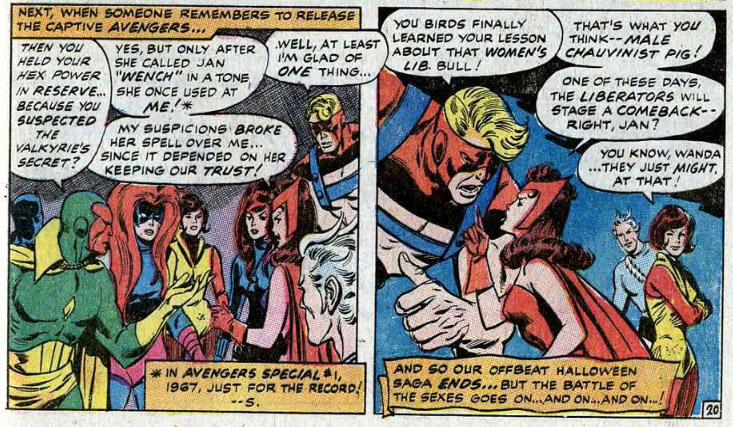
AND THEN THE LIBERATORS DON’T COME BACK FOR DECADES (and even then it’s not the same group with the same aims). We—the readers—were robbed, I tell you. ROBBED.
AD OF THE WEEK:

Just don’t, I guess.
NEXT TIME: Goliath gets it in the eye from Tom Thumb!
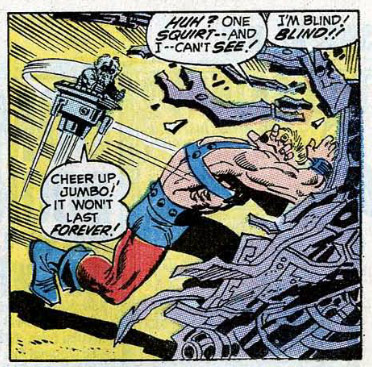


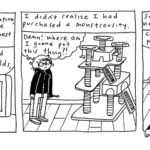
![[REVIEW] THE ILLUSTRATED FORGOTTEN FAIRY TALES OF FRANZ XAVER VON SCHÖNWERTH ARE FABULOUS FOR ADULTS](https://geekd-out.com/wp-content/uploads/2019/07/fairy2-150x150.jpg)